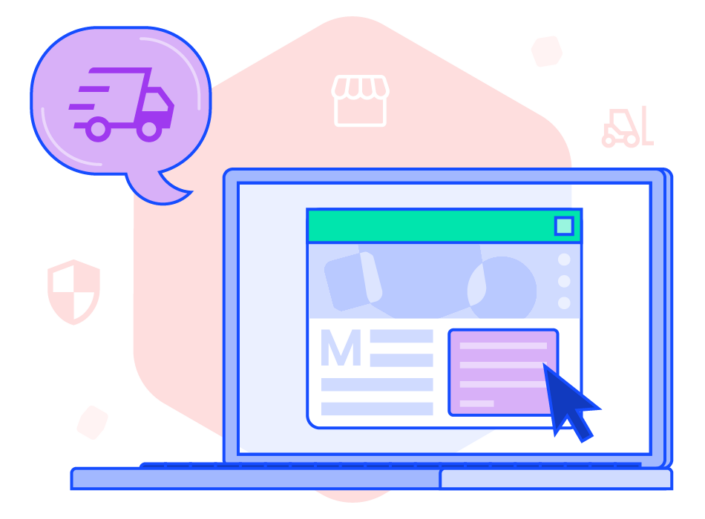Using reliable shipping for ecommerce is one of the most important aspects of running an online business. After all, you can’t sell anything if it can’t reach your customers.
This guide will discuss everything you need to know about ecommerce shipping. We’ll start by explaining what it is and how it works. Then we’ll dig deeper into strategies and the best solutions to enhance your logistics. So get your corrugated boxes and packaging tape ready because you’ll be a shipping expert by the end of this guide.
Here’s a quick breakdown of what you can expect:
- What is ecommerce shipping?
- What is the process of ecommerce shipping?
- Ecommerce shipping strategies
- Calculating ecommerce shipping costs
- Tips to improve ecommerce shipping processes
- Why choose EasyPost as your ecommerce shipping service?
What is ecommerce shipping?
Ecommerce shipping is the process of delivering goods purchased online from a seller to a customer. From the customer’s point of view, they usually click a few buttons, submit their order, and a package arrives in a few days, but the business logistics are a little more complicated than that.
Once an order is placed, a fulfillment center packages the goods and passes them onto a carrier for delivery. Shipping carriers are transportation companies that move goods from one place to another. There are many different shipping carriers, but most people have heard of the big ones like UPS, FedEx, DHL, and USPS. Each carrier has its own strengths and weaknesses, so it’s important to choose the right one for your business.
Shipping is the link between ecommerce businesses and their customers. Without it, you wouldn’t be able to sell or deliver goods to your customers. However, it can also have a significant impact on customer satisfaction. For example, if your products take too long to arrive, your customers will be unhappy. Additionally, if products come damaged, you’ll also have unhappy customers. That’s why choosing the right shipping solutions for your business is important.
What is the process of ecommerce shipping?
The ecommerce shipping process breaks down into a few key steps. First, you need to persuade a shopper to make an order. Then, once the order is placed, you’ll need to process it and package it with the correct shipping information before passing it to a carrier who will ensure it arrives safely at its destination.
While this may seem like a lot of work, shipping logistics can become a well-oiled machine once you get the hang of things. And with the help of ecommerce shipping services and technology, you can make the process even easier. In this next section, we’re breaking down the process of ecommerce shipping and sharing some tips and tricks that will help you along the way.
Placing an order
The shipping process starts when an order is placed. This is usually done on a website or mobile device, but can also be done over the phone or in person. During the checkout process, customers must provide their shipping information, including their name, address, and contact details.
If you’re using ecommerce shipping software, this information will automatically be entered into your system. In either case, it’s important to double-check that all of the information is correct to avoid any delays or mix-ups.
Processing an order
Once an order is placed, you’ll need to pick the products from your warehouse shelves and pack them into boxes or mailers. Make sure to include any relevant paperwork, like invoices or packing slips. When the products are packed and ready to go, you’ll need to label them with the correct shipping information.
If you’re using ecommerce shipping software, the labels will be automatically generated, and you’ll just need to print them out. If you’re going without, you’ll need to create the labels yourself. Either way, it’s important to ensure that the labels are correct and legible to avoid delays.
Shipping an order
After an order is processed and labeled, it’s ready to be shipped. First, you’ll need to choose a shipping carrier and send the package off. Some ecommerce businesses will do all of their shipping through one carrier, but many have found it’s more cost-effective to work with several carriers. Then they are able to compare carrier rates and reliability to ensure they are getting the best option. Once you choose a carrier and pass the parcel onto them, they will take care of delivering the package to the customer’s door.
After an order is shipped, you’ll need to track it to ensure that it’s delivered safely and on time. You can do this by tracking the package with the shipping carrier or through your shipping software if it has the capability. If there are any problems with the delivery, tracking information will enable you to take action to fix them.
Retaining the customer
The shipping process doesn’t end when the order is delivered. You’ll also need to retain the customer by providing good customer service and following up after the order has been delivered. If you’re using ecommerce shipping software, you’ll be able to automate some of these tasks, like sending thank you emails or tracking customer satisfaction. Otherwise, you may have to do these tasks manually. Either way, it’s important to make sure you’re providing good customer service and following up with your customers.
Ecommerce shipping strategies
Now that we’ve gone over the basics let’s take a closer look at some of the different shipping strategies businesses can use. Of course, each shipping strategy has its pros and cons, so it’s important to choose the one that’s best for your company.
The best ecommerce shipping strategy for your business depends on your products, budget, and customer base. So if you’re unsure which strategies to use, don’t worry. We’ve broken down some common dilemmas many shippers find themselves in.
Two-day shipping vs. standard shipping
Two-day shipping is a popular strategy. It’s fast, reliable, and customers love it. However, it’s also more expensive than standard shipping and can take more logistics resources to meet quick turnaround times regularly.
Standard shipping is a slower option, but it’s less expensive than two-day shipping and can be less reliable. Standard shipping is a good option for businesses that are just starting out or that sell products that aren’t time-sensitive.
When choosing between two-day shipping and standard shipping, it’s important to choose the one that’s best for your business. If you’re not sure which one to choose, you can always experiment with both options to see which one works best for you and your customers.
Free shipping vs. paid shipping
Consumers want to feel like they’re getting a good deal, so free shipping can be incredibly appealing to ecommerce shoppers compared to paid shipping. While this can be expensive for businesses if they choose to take a loss on shipping costs, it can boost sales by drawing in more customers. Alternatively, businesses can still offer free shipping while building rate prices into their product prices.
As the name suggests, paid shipping requires shoppers to pay to ship their orders. Because many shoppers are used to the convenience of free shipping from some retailers, this option is less enticing for consumers. It is, however, less expensive for businesses.
Ecommerce retailers who can’t justify the cost of free shipping can find ways to meet consumers in the middle. Requiring online orders to meet a certain threshold, like $30 or $50, to receive free shipping is both appealing to consumers and beneficial to businesses. Free shipping and paid shipping aren’t one size fits all solutions, so it helps to consider your options before committing to one or the other.
Table rate shipping vs. flat rate shipping
Shipping rates are one of the most important factors when choosing an ecommerce shipping strategy. Table rating is a shipping option that charges different rates depending on a package’s weight, size, and destination. On the other hand, flat rate shipping charges a standardized fee regardless of those factors. Because of its flexibility, many businesses find table rating to be the better of these strategies. However, if a business has a small number of products with similar sizes and prices, a flat rate could prove to be cost-effective.
Single-carrier shipping vs. multi-carrier shipping
Single-carrier shipping is when you use one carrier for all of your ecommerce shipments. This can be a good option if you have a preferred carrier or if you want to simplify your shipping process. However, it does lock you into that carrier-including their rates, transit items, and customer service.
Multi-carrier shipping is when you use multiple carriers for ecommerce shipping. Using this strategy, shippers can compare rates and transit times to find the best option for their customers. This strategy is more complex than single-carrier shipping, but a powerful shipping software should help to simplify the process and save money in the long run.
3PL fulfillment vs. in-house fulfillment
There are two main types of fulfillment strategies that ecommerce businesses choose: third-party logistics providers and in-house fulfillment. 3PLs are companies that store and ship ecommerce orders on behalf of other businesses. In-house fulfillment is when a business stores and ships those orders from its facilities.
There are pros and cons to both strategies. Generally, 3PLs are more expensive and more reliable. In-house logistics can usually be achieved more affordably, but the business must manage the complexities of shipping logistics.

Calculating ecommerce shipping costs
Now that we’ve gone over some basics of ecommerce shipping, let’s talk about how shipping costs are calculated. Shipping costs are typically based on a few factors, including package weight, shipping distance, and transit times. However, on the consumer side, many simply want the best price possible. The challenge of calculating ecommerce shipping costs comes down to offering the best rates without sacrificing profits. You’re not alone in this challenge—here are some common questions we’re asked about this subject.
How is ecommerce shipping calculated?
There are several factors that shipping carriers take into account when calculating shipping rates:
- Package weight
- Package dimensions
- Final destination
- Transit time
- Package value
The carrier will use these factors to determine how much it will cost to ship a package from point A to point B. With so many carriers to choose from, businesses are left to find the shipping companies that offer the most competitive rates without sacrificing transit times or customer service.
How much should I charge for ecommerce shipping?
This is a common question with no easy answer. It depends on your shipping strategy, your products, your shipping costs, and your margins. You’ll need to do some calculations to figure out what shipping rates you can afford without reducing profits. This may seem like a daunting task, but a shipping software can help with this by automating calculations and giving you real-time shipping rates from multiple carriers.
How can I reduce ecommerce shipping costs?
There are actions both small and large ecommerce businesses can take to reduce shipping costs:
- Negotiate shipping rates with carriers
- Reduce package size and weight
- Find discounted shipping supplies
- Ship with multiple carriers
- Insure packages through a third party
Do some research and figure out which shipping strategy will work best for your business. A little bit of planning can go a long way in reducing shipping costs. In our 5 Ways to Stop Overpaying in Shipping Costs article, you can learn more about this subject.
Tips to improve ecommerce shipping processes
Shipping can be a complex and costly process, but there are steps you can take to make it more efficient and save money in the long run. You can implement these practices on your own, or you can work with a company, like EasyPost, to help improve your ecommerce shipping processes. EasyPost offers simple ecommerce shipping that helps users achieve faster, more flexible, and more reliable shipping through our suite of shipping APIs. Here are a few ways ecommerce shipping services or software can help improve your processes.
Automatic label creation
One way to improve ecommerce shipping processes is to automate the label creation process. This speeds up operations by eliminating the need to print and apply labels manually. This can be accomplished with a shipping software that integrates with your ecommerce platform and connects with all of your carriers.
EasyPost’s Shipping API easily integrates with over 100 carriers worldwide, which means you’ll always have access to the best rates—and you don’t have to worry about the reliability of our platform because ours is the best in the business with 99.99% uptime.
Find the best shipping rates
Another way to improve ecommerce shipping processes is to find the best shipping rates. This can be done with shipping software that compares rates from multiple carriers and finds the best price for your shipment. Not only does this save your business money, but it also saves your customers money. And when customers save on shipping, they’re more likely to shop with you again in the future.
EasyPost’s SmartRate API is the first-ever rating engine to return both prices and time-in-transit predictions. With 98% accuracy, you can confidently offer your customers the best shipping experience possible without overspending on shipping costs.
Verify shipping addresses
One of the shipping process’s most important—and often overlooked—steps is address verification. This helps ensure packages are delivered to the correct location before a parcel leaves your facility. In addition, it prevents costly mistakes that arise when a package doesn’t make it to the right destination.
EasyPost’s Address Verification API is fully CASS-certified with 99.98% accuracy, which means you can confidently ship to any address in the U.S. without worrying about whether or not it’s correct.
Real-time shipment tracking
Real-time shipment tracking allows both businesses and customers to see where their package is at every step of the shipping process-from fulfillment to transit to delivery. Today, many online shoppers expect businesses to share shipment tracking information. It gives them peace of mind knowing that their package is on the way, and they can keep an eye on things if there are any delays.
EasyPost’s Tracking API provides real-time shipment updates through webhook notifications that lead to custom-branded tracking pages. This means your customers will always know where their package is located until the moment it arrives safely at its destination.
Review data regularly
Finally, don’t forget to review your shipping data regularly. This helps businesses identify areas where their shipping processes can be improved and enables them to make changes that will help them optimize their logistics operations.
EasyPost’s carrier tracking data allows users to build reports and dashboards that provide real-time visibility into supply chain performance. This data can be leveraged to make complex decisions less complicated and provide direct insight into package-level details, carrier performance, and delivery statuses.

Why choose EasyPost as your ecommerce shipping service?
At EasyPost, we remove the technical complexities of logistics so our users can get back to growing their business. We help our users save on shipping by creating the fastest, most reliable shipping APIs in the industry. We are always expanding our platform with new solutions to help businesses thrive with the goal of being the best ecommerce shipping solution on the market.
Here are just a few of the ways EasyPost enables businesses to ship smarter:
- Multi-carrier access
- Label generation
- Data backed optimization
- Package tracking
- Address verification
- Shipping insurance
- Carbon neutral shipping
- Partner white labeling
What makes EasyPost different from the competition?
You may be wondering what makes EasyPost the best ecommerce shipping solution. Well, compared to the competition, EasyPost is the fastest, most reliable, and most flexible shipping solution on the market. When our users succeed, we succeed. So whether you’re a Fortune 100 company, a small neighborhood store, or somewhere in between, EasyPost is excited to help you ship packages worldwide—and here’s why you should choose us.
Speed
EasyPost’s shipping APIs use the newest and fastest technology. This empowers ecommerce businesses to print labels rapidly, whether they’re shipping 10 packages per year or 10 million. Many competitors rely on outdated technology that can potentially slow label generation down to one label per second, which many businesses don’t have time to wait for.
Reliability
EasyPost’s APIs are the most reliable in the industry, with 99.99% historic uptime-even during peak season. Unlike EasyPost, competitor shipping companies use older, more unstable technologies that often experience downtime and regular maintenance outages. When labels don’t print, shipments are delayed and delivery guarantees are missed. Keep your labels printing year-round with EasyPost.
Flexibility
EasyPost’s shipping APIs are designed to be flexible and easily adaptable to meet the unique needs of ecommerce businesses. Other shipping technologies are more rigid, making it difficult, or even impossible, to integrate with the unique needs of ecommerce businesses.
Support
At EasyPost, we pride ourselves on world-class customer support. Enterprise users gain access to our dedicated support team. And as a tech company, we know the value of thorough documentation—unlike some competitors who have difficult documentation on top of slow support response times.
Shipping is the foundation of ecommerce
Without today’s shipping infrastructure, ecommerce shipping wouldn’t exist. Consumers can make orders online and have them delivered within a few days-sometimes even less. ecommerce shipping can be complex, but by automating certain processes and regularly reviewing data, businesses can streamline shipping and provide a greater customer experience.
And that is exactly what EasyPost is designed to help you deliver. Sign up for free today or speak with one of our shipping experts to learn how EasyPost can simplify your shipping logistics.




